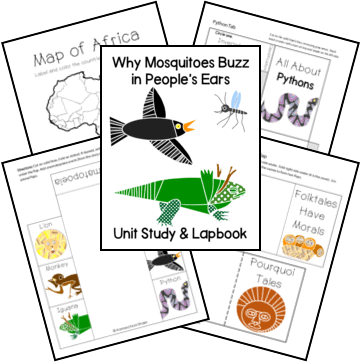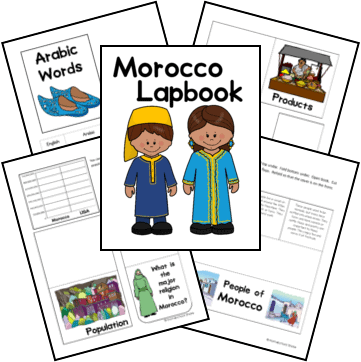Affiliate Disclaimer
We sometimes use affiliate links in our content. This won’t cost you anything, but it helps us to keep the site running. Thanks for your support.
This literature based unit study includes lessons and printables based on the book Why Mosquitoes Buzz in People’s Ears by Verna Aardema.
In Why Mosquitoes Buzz in People’s Ears, Mosquito tells a story that causes a jungle disaster. Grab our free Why Mosquitoes Buzz in People’s Ears unit study and lapbook and have fun with this West African tale.
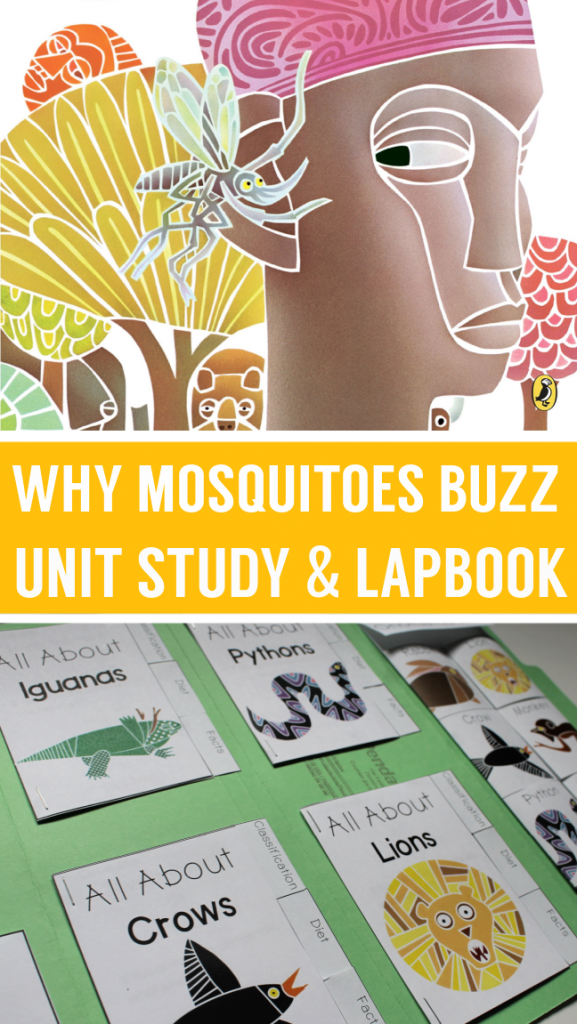
Thanks to Wende for writing the lessons for this Why Mosquitoes Buzz in People’s Ears unit study.
Why Mosquitoes Buzz in People’s Ears Activities & Lessons
Here are some sample lessons from the Why Mosquitoes Buzz in People’s Ears Unit Study.
Geography: Western Africa
This story takes place in Western Africa. Africa is the second largest continent in the world. Locate Africa on a world map. Africa has deserts, mountains, grasslands, and tropical rain forests. Western Africa includes countries along the Atlantic coast, the largest of which are Nigeria, Congo, Ivory Coast, and Cameroon. The equator runs through Western Africa, making it one of the hottest places on earth. Because most of these countries were once ruled by European nations, the majority of people speak English, French, or Portuguese, but there are also some groups that speak a number of African languages including Swahili. Important crops in Western Africa are cocoa, coffee, palm oil, and rubber. People grow yams, cassava, millet, and corn for food.
While there are areas that have been modernized with factories, schools, and hospitals, many of the people living in Western Africa are living the same way as their families have for centuries, in huts made of bamboo or grass, with no electricity or running water, and are telling the same folktales that their great-great-grandparents told.
Science: Jungle Animals
Choose at least two of the animals mentioned in the story to study.
Mosquito: Mosquitoes are bothersome insects. What makes them an insect? All insects have three body parts, a head, thorax, and abdomen. All insects have six legs, and some have two antennae on their heads. And all insects reproduce by laying eggs. A female mosquito lays her eggs in water. A wriggler hatches from each of the eggs and it eats the tiny plants in the water. After a week, the wriggler changes into a pupa, which floats just underneath the surface of the water. A few days later the pupa’s skin splits down the back, and a winged mosquito comes out and flies away. The mouthparts of the female mosquito are designed for piercing and blood sucking. The male mosquito feeds on plant fluids and does not bite or suck blood. Mosquitoes can pass diseases onto their victims when they inject them with their infected salivary fluid. Mosquitoes only live in areas with water, such as a moist African rain forest, or near pools, swamps, or marshes. It is important to not leave containers outside that can collect water, as this is where mosquitoes will breed and multiply.
Iguana: Iguanas are reptiles in the lizard family. What makes them a reptile? Reptiles have backbones, are cold blooded, breath with lungs, and lay eggs. Iguanas can reach up to 6 feet in length and can weigh up to 20 pounds. They have rows of leathery spikes from the neck to the base of the tail, which they sometimes use as a whip to protect themselves. An iguana’s tail can regenerate itself after being broke off. An iguana’s diet consists of fruit and vegetation, and some will even eat small rodents, birds, or bird eggs.
Python: Pythons are reptiles in the snake family. Like the iguana, pythons have backbones, are cold blooded, breath with lungs, and lay eggs. Most are about ten feet long, but they have been seen up to forty feet long! Pythons live in trees near water, in tropical climates. They eat small mammals such as rabbits after strangling them in their coils.
Rabbit: Rabbits are mammals. What makes them a mammal? They have backbones, are warm blooded, and breath with lungs. They have live births and give milk to their babies. Rabbits’ bodies are covered with fur. Rabbits live all over the world in underground burrows. Rabbits have three to eight babies in each litter, and up to eight litters a year. They feed off of herbs, bark, and other vegetation, and can be a nuisance to farmers.
Crow: Crows are black birds that are found in nearly all parts of the world. Birds have backbones, are warm blooded, breath with lungs, and lay eggs. Crows are omnivores, meaning they eat both plants and meat. Crows are known for their loud caw.
Monkey: Monkeys are mammals that live in groups called troops high in the tropical forest trees. They eat plants, birds’ eggs, small animals such as owlets, and insects. Monkeys have long tails, which they use to swing from and for balance. A female monkey usually has just one baby, but sometimes she will have twins.
Owls: Owls are birds of prey that live all over the world. They hunt animals such as mice and rabbits at night. Owls have large eyes, very sensitive hearing, and soft feathers that allow them to fly silently. They can swivel their heads almost completely around (180 degrees).
Lion: Lions, called King of the Beasts, are the largest predators in Africa. They live in the grasslands, and will sometimes venture into the jungles. Like rabbits, they are mammals. Lions live in groups called prides, which are made up of many females and a few males. The Lioness (female Lion) does most of the hunting, its prey of which includes antelope, zebra, and buffalo. The male Lion’s job is to protect the pride.
Social Studies: Traditions and Morals
A folktale was a story that was traditionally told by adults to their children to teach the children how to behave and/or explain why something is. When a story is designed to teach you something, it is called a moral. What do you think the lesson or the moral of this story is? Can you think of any other stories that have morals? Read some of Aesop’s Fables to discover more stories with morals.
You can grab a copy of the entire Why Mosquitoes Buzz in People’s Ears Unit Study and Lapbook in an easy-to-print file at the end of this post.
Why Mosquitoes Buzz in People’s Ears Lapbook Printables
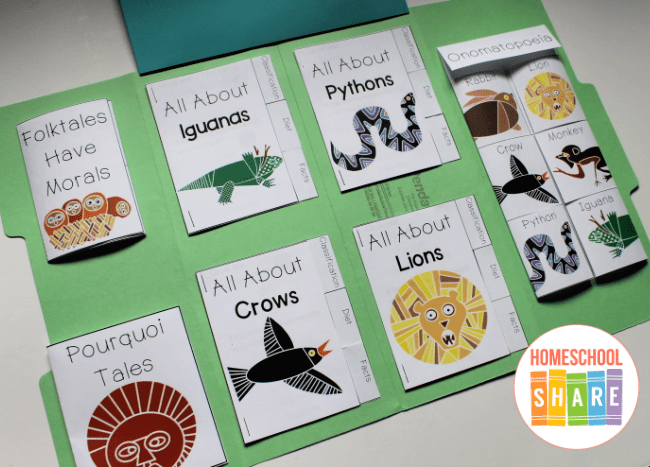
In addition to the unit study lessons, the file includes these mini-books for your student to create a Why Mosquitoes Buzz in People’s Ears lapbook:
- Folktales Have Morals Flap Book
- Pourquoi Tales Simple Fold
- Onomatopoeia Shutterflap Book
- Mosquito’s Response Pocket
- Map of Africa
- All About Monkeys Tab Book
- All About Pythons Tab Book
- All About Mosquitoes Tab Book
- All About Owls Tab Book
- All About Rabbits Tab Book
- All About Lions Tab Book
- All About Crows Tab Book
- All About Iguanas Tab Book
- Story Comprehension Cards (store in an envelope in your lapbook)
How to Get Started with Your Why Mosquitoes Buzz in People’s Ears Unit Study & Lapbook
Follow these simple instructions to get started with the Why Mosquitoes Buzz in People’s Ears Unit Study:
- Buy a copy of the book, Why Mosquitoes Buzz in People’s Ears, or borrow one from your local library.
- Print the Why Mosquitoes Buzz in People’s Ears unit study.
- Choose the lessons you want to use with your student (a highlighter works great for this).
- Choose and prepare the lapbook printables you want to use with your student.
- Enjoy a week of learning with Why Mosquitoes Buzz in People’s Ears.
Why Mosquitoes Buzz in People’s Ears Lapbook Sample
Here is a sample lapbook for this literature based unit study.
The lapbook is one file folder with a center extension added. The extension is a piece of cardstock taped to the center of the lapbook.
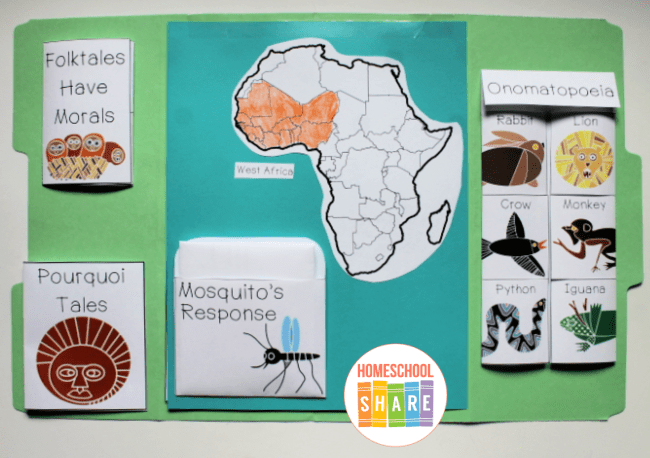
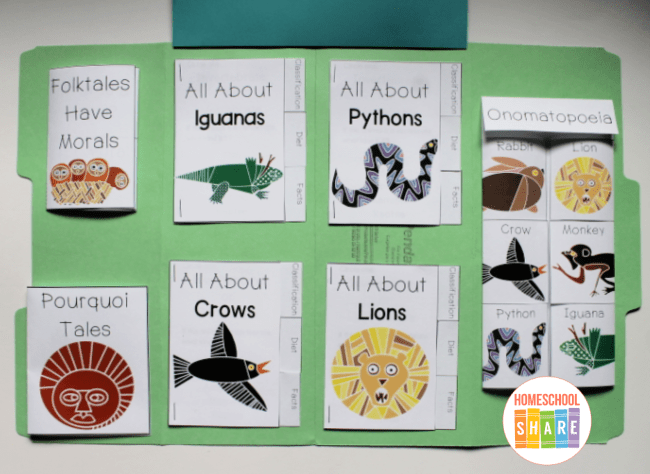
Get Your Free Why Mosquitoes Buzz in People’s Ears Unit Study & Lapbook
Simply click on the image below to access your free Why Mosquitoes Buzz in People’s Ears Unit Study and Lapbook.

